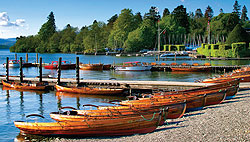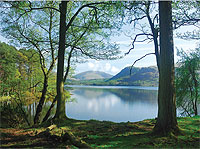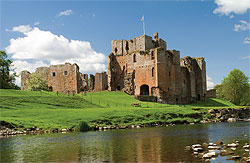Home to poet and artist John Ruskin and children’s author Beatrix Potter, the Lake District continues to charm visitors with its breathtaking landscapes, picturesque pubs and award-winning attractions
Tucked away in one corner of north west England, the Lake District is quite unique. Just 30 miles across, this verdant corner contains England’s highest and craggiest mountains and deepest and largest lakes, all closely packed together in the most spectacularly beautiful landscape.
 |
| Boats line the shores of Bowness-on-Windermere |
Awe-inspiring peaks and rolling fells tower over lush green valleys, where sheep graze peacefully beside moss-covered dry stone walls. Now preserved forever as the Lake District National Park, this lovely corner of the country is quintessentially English. And this landscape is also wonderfully compact, so you can stride over grassy slopes with spectacular views of idyllic lakes far below, set against imposing peaks.
The Lake District – or simply the Lakes – has a long pedigree. This extraordinary landscape was formed by volcanoes, earthquakes and an Ice Age, which left craggy peaks of volcanic stone, a deliciously crumpled landscape and wonderful glacial valleys.
High above Keswick, Castlerigg stone circle is an evocative reminder of early settlers and their place amid awe-inspiring peaks. Scandinavian settlers, too, left their mark on this landscape, with a unique Lakes vocabulary – “tarn” for small mountain lake, “force” for waterfall, “fell” for hill, “gill” for ravine and “beck” for stream, in a part of the world where visitors are never far from a tinkling beck or gushing force. And when the medieval abbeys started making their riches from the wool trade, they opened the way for the sheep that now graze on every idyllic corner of Lakeland pastures.
 |
| The peaks of Walla Crag and Blencathra over Derwent Water |
Given the unique charm of the Lakes, small wonder then that some of the country’s best writers lived and loved here. In the tiny Dove Cottage in Grasmere, the poet William Wordsworth lived with his sister Dorothy, and then his wife Mary, too, and their first three children. Visitors knock at the front door as a cuckoo clock chimes deep within, and then perch on a deep window seat or beside the fire to peruse Dorothy’s journal entries for that week.
Her account of nodding daffodils beside Ullswater, after an idyllic spring 1802 walk, inspired her brother’s most famous poem. Dove Cottage drew other literary giants too – the poet Samuel Taylor Coleridge, who was a frequent visitor, and the writer Thomas de Quincey who lived there when the expanding family had moved to the imposing Rydal Mount for the 37 years until Wordsworth’s death in 1850, and which became his “best loved family home”.
In tiny Dove Cottage, patches of blackened wall still attest to the smokiness of the candles the Wordsworths made in the tiny kitchen. “They would burn with a terrible smoke, because of the fat content of the mutton,” muses guide Esther Rutter, “so there was very little light, and they had terrible eyesight. Wordsworth composed a lot of his poetry while walking on the fells, or in the garden.” And while the four-acre fellside garden at Rydal Mount, landscaped by Wordsworth, is simply stunning, the small and steeply-rising garden behind Dove Cottage is elegant in its simplicity, too. Inside, furniture, family possessions and portraits are displayed and it takes just a little imagination to see Wordsworth scribbling there, peering through the thick lenses which are still on display at Dove Cottage.
The natural beauty of the area drew other literary giants too – Beatrix Potter, who loved the area as a child, and bought her idyllic farmhouse Hill Top in 1905. She left the house to the National Trust asking that furnishings, the library and pretty garden should stay just as she left them. So visitors today can tiptoe around the evocative rooms, and hold up copies of her beautifully-illustrated books to match them to the objects which inspired the author’s illustrations such as The Tale of Jemima Puddle-Duck.
 |
| The picturesque village of Troutbeck |
With 12 million visitors a year, it would be horribly easy for visitors to overwhelm the gracious Lakes scenery they have come to enjoy. But the sheer compactness of the Lakes means that walking or taking a ferry across an idyllic lake is easy. So visitors today reach Hill Top much as Beatrix Potter did – she travelled across Lake Windermere by ferry to visit her mother Helen at her home at Lindeth Howe, now an elegant country house hotel, and visitors today can travel by boat, minibus and with their own pair of stout walking shoes.
Walking in the Lakes is perhaps the best way to enjoy this magnifi cent landscape, with rapidly-changing vistas and weather conditions: one moment a view of the sun-drenched slopes of Helvellyn, the next a glimpse of Scafell Pike swathed in mist. So a walk around Tarn Hows, once owned by Beatrix Potter, is an idyllic stroll past meadows grazed by the author’s beloved Herdwick sheep, and with a pause for delicious home-made cakes at Yew Tree Farm – Beatrix Potter once owned this farmhouse, which doubled as Hill Top in the 2006 movie Miss Potter, starring Renée Zellweger and Ewan McGregor.
Part of the magic of the Lakes is that every valley is different. So the imposing grandeur of Wast Water, England’s deepest lake and surrounded by the country’s highest mountains, is a world away from the gentle beauty of the Borrowdale valley. Climb high on the fells, and you look down into yet another idyllic valley with a charm all its own.
So from Grasmere visitors can walk briskly uphill from Dove Cottage, pausing at the coffin stone where generations of bearers once rested a coffin en route to its final resting place at St Oswald’s in the village. High up on the fells, the walk to Alcock Tarn gives spectacular views over Grasmere and beyond, with an exhilarating descent for a pint at the 16th-century coaching inn the Traveller’s Rest, and then a stroll into the village.
Just beyond St Oswald’s churchyard, where the Wordsworth graves cluster under giant yews, visitors are irresistibly drawn to the aroma wafting from the tiny former schoolhouse, which is now home to Sarah Nelson’s celebrated Grasmere gingerbread. “The secret recipe has been handed down through the generations,” says chief gingerbread man Andrew Hunter, the only person in the world who knows the recipe scrawled on yellowing paper and now safe in a bank vault, “and people come back year after year for our gingerbread.”
The scents of freshly-baked bread fill the air at Wordsworth House too – the poet’s childhood home in Cockermouth that he shared with his four siblings. It has been lovingly re-created by the National Trust to that era, complete with servants going about their daily chores. But then good, wholesome food is as much a part of the Lakes as the fresh air which gives walkers such an appetite: hearty soups, crusty breads, delicious home-made cakes and ice creams are simply irresistible after a day on the fells or lakes.
 |
| Built on a Roman site near Penrith, Brougham Castle dates back to the 13th century |
“Walking up to Black Crag takes about an hour from here and gives stunning all-round views over the Langdales and Lake Windermere,” confi rms Stephen Dodd, who runs the multi-award winning Drunken Duck pub near Ambleside, “and then they’re ready for lunch and a drink.” With its own brewery, and ales named after the family’s deceased pets, the Drunken Duck takes its name from the Victorian pub landlady who found her ducks lying stretched in the road, and started to pluck them for the pot, not realising that a beer barrel had drained into their feeding ditch. When they woke she was so mortified that she made the de-feathered birds little knitted jerseys until their feathers grew back.
These fells and valleys, once so remote that they horrified 17th-century travellers who found them inhospitable, are now much easier to reach. So, on Coniston Water, which inspired Arthur Ransome’s Swallows and Amazons books, and Donald Campbell’s attempt to break his own world water speed record in 1967 and which took his life, the Steam Yacht Gondola takes summer visitors to Brantwood, the idyllic home and gardens of the 19th century art critic and author John Ruskin.
And while Lakes lovers including Wordsworth opposed the introduction of steam ferries on Lake Windermere, and the coming of the railway in 1847 which prompted the growth of the town of Windermere, the new ease of access also brought stunning new design to the Lakes. On the edge of Bowness, home of the interactive World of Beatrix Potter in the Old Laundry, Blackwell is the unique Arts and Crafts holiday home of a Manchester brewer whose designer called it “a charmed territory where everything shall be in harmony.” Blackwell’s stunningly elegant organic design and views over Lake Windermere are just breathtaking. “The light and the calm of the White Room are always wonderful, no matter what the weather is doing or how you are feeling,” agrees Susan Laisby, who greets visitors on arrival. Arts and Craft garden design comes into its own too in the gardens of Brockhole, stretching down to the shores of Lake Windermere, and now the National Park Visitor Centre.
Those idyllic lakeside settings with their ever-changing vistas make the Lakes and their stunning rural beauty a place to visit time after time.






 © 2024
© 2024